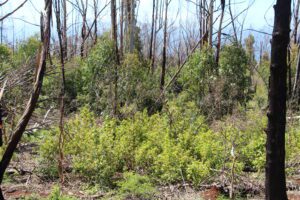Kaua‘i
Near the geographic center of Kauaʻi is one of the wettest known places on earth, Mount Waiʻaleʻale. Despite this, wildfires can and do occur on the island. Steep slopes, rough terrain, difficult access, a large percentage of highly ignitable invasive grasses, and numerous threatened and endangered native species characterize the Kauaʻi landscape.
Ignitions occur regularly in the inhabited areas of the island, mostly near the coasts, where the landscape is dominated by current and former agricultural lands as well as grass and brush.
Kauaʻi is among the oldest high Hawaiian Islands and has been shaped by significant erosion, creating its dramatic landscape of valleys. Some of the steepest and least accessible areas include the North Shore to the West side, which also correspond strongly with the highest concentration of threatened and endangered species. This creates a challenging environment for reaching and containing fires when they occur, and presents a risk to the resident endangered species. >> READ MORE
After fires burn through an area of native vegetation in Hawaiʻi, the rebounding vegetation is generally dominated by fast growing non-native grasses and shrubs. Not only does this negatively impact biodiversity, but this can also contribute to erosion and the risk of landslides especially on the steep slopes of Kauaʻi.
The biggest large fires have historically occurred on the lee slope of the eastern flank of Waimea valley. This presents a concerning fire risk for the drought-prone community of Kekaha.
Kauaʻi is known for its high rainfall, but annual rainfall is not always a good indicator for risk. Particularly wet periods over a rainy season can, counterintuitively, significantly elevate hazard levels. Increased precipitation may lead to a surplus of vegetation growth, becoming potential fuel during subsequent drier periods, thereby elevating the risk of large wildfires. Given the changing wind and rainfall patterns arising from climate change, this may lead to increased risk for Kauaʻi.
Recent Resources For Hawai‘i
Learn the perspectives of Amy Tsuneyoshi and Kaimana Wong from the Honolulu Board of Water Supply (HBWS) and Mikaela Bolling from the Waianae Mountain Watershed Partnership (WMWP) with respect to fire breaks and fire prevention.
Fountain grass is an invasive, highly flammable ornamental plant that has overtaken the dry, tropical ecosystems of west Hawaii. Over the last several decades, large, fast spreading fountain grass fires have burned across the landscape with increasing frequency, usually ignited by roadside activities in remote areas. The Pu’u Anahulu Fuels Management Project evaluated the effectiveness of different roadside fuels treatments on fountain grass using a collaborative approach, and allowed the first use of science-based fuels treatments and prescribed fire in Hawaii. Demonstration sites were established along roadsides where ignitions were known to occur. The clear winner for sustained reduction of fountain grass was a three stage application of prescribed fire, grazing and herbicide.
This project was developed and carried out by SWCA Environmental Consultants (SWCA) to determine the effectiveness of three different methods in reducing the surface fuel loads in a guinea grass (Panicum maximum) dominated community, thereby reducing susceptibly to sustained fires. Three control treatments were tested including mechanical removal, herbicide application and grazing using cattle to reduce the fuel loads at Marine Corps Training Area Bellows (MCTAB), on the island of O‘ahu, Hawai‘i. Information on the cost of the various control treatments and their long-term effectiveness in maintaining reduced fuel loads would also benefit land and resource managers in the Pacific Islands where guinea grass and frequent fires are problematic.





